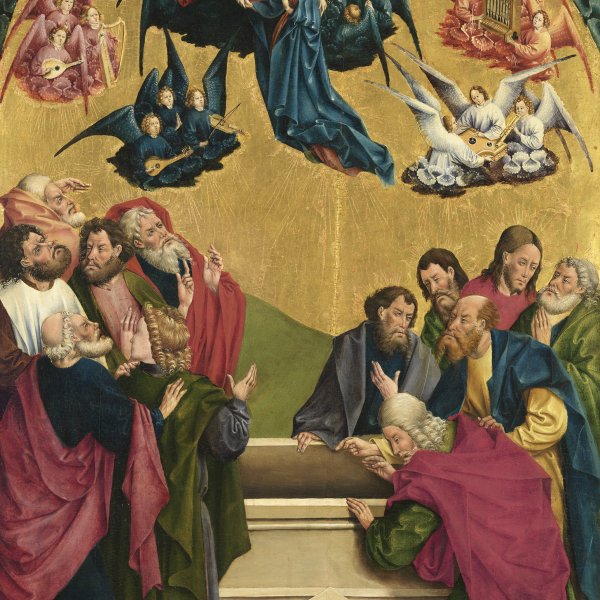Johann Koerbecke
(?) ca. 1420-Munster, 1490
Koerbecke was a German painter active in the area of Westphalia, who may have originated from Coesfeld near Munster. Nothing is known of his early training although it is possible that he studied with his father, Hermann Koerbecke, or with another local artist in the late 1430s. After his father’s death in 1442 Koerbecke appears in documents as a painter with a prominent social position. It is also known that he ran a successful family workshop and that he had a significant number of apprentices and assistants. Between 1440 and 1460 Koerbecke was a member of the confraternity of Our Lady of Saint Egidius in Munster.
Among the first works attributed to the artist are two panels with scenes of the Passion dated to around 1450 (Westfälisches Landesmuseum, Munster), painted for the collegiate church at Langenhorst. Also associated with that church are two paintings of Saint John the Baptist and Saint George or Saint Christopher, and finally another three that were part of an altarpiece dedicated to Saint John the Baptist (now divided between the Munster Museum and the Rijksmuseum Meermanno-Westreenianum, The Hague). Koerbecke’s most important and characteristic work of his mature phase is the altarpiece for the abbey church in Marienfeld, installed in 1457 (now divided between various collections including the Art Institute of Chicago, the Musée Calvet, Avignon, the Museo Thyssen-Bornemisza, Madrid, and the National Gallery of Art, Washington). All these panels were identified as part of the altarpiece on the basis of a drawing of it by the painter Johann Christoph Rincklake (1764–1813).
Koerbecke’s style reveals the influence of Netherlandish painting as well as that of the painter Konrad van Soest. His compositions are notable for the construction of the perspectival space, the realistic landscapes and confident rendering of the human body. With regard to the latter, Koerbecke was evidently influenced by late Gothic art and the work of the Master of Schöppingen. His death on 13 June 1490 is noted in the registry of deaths of the Cistercian monastery of Marienfeld, but his workshop continued active under Hermann, one of his sons, until at least 1495.
Among the first works attributed to the artist are two panels with scenes of the Passion dated to around 1450 (Westfälisches Landesmuseum, Munster), painted for the collegiate church at Langenhorst. Also associated with that church are two paintings of Saint John the Baptist and Saint George or Saint Christopher, and finally another three that were part of an altarpiece dedicated to Saint John the Baptist (now divided between the Munster Museum and the Rijksmuseum Meermanno-Westreenianum, The Hague). Koerbecke’s most important and characteristic work of his mature phase is the altarpiece for the abbey church in Marienfeld, installed in 1457 (now divided between various collections including the Art Institute of Chicago, the Musée Calvet, Avignon, the Museo Thyssen-Bornemisza, Madrid, and the National Gallery of Art, Washington). All these panels were identified as part of the altarpiece on the basis of a drawing of it by the painter Johann Christoph Rincklake (1764–1813).
Koerbecke’s style reveals the influence of Netherlandish painting as well as that of the painter Konrad van Soest. His compositions are notable for the construction of the perspectival space, the realistic landscapes and confident rendering of the human body. With regard to the latter, Koerbecke was evidently influenced by late Gothic art and the work of the Master of Schöppingen. His death on 13 June 1490 is noted in the registry of deaths of the Cistercian monastery of Marienfeld, but his workshop continued active under Hermann, one of his sons, until at least 1495.





